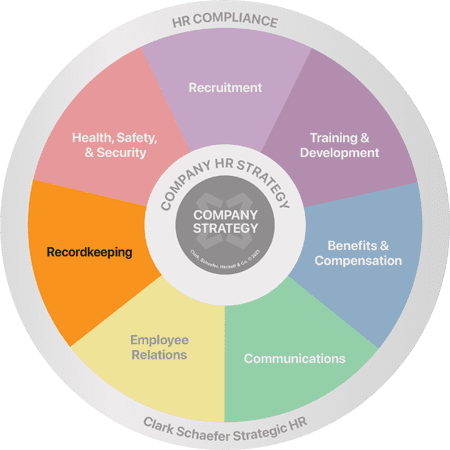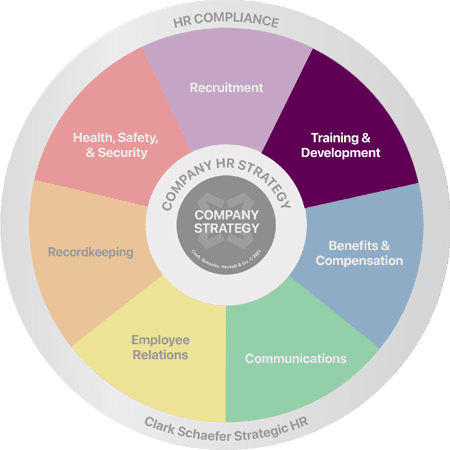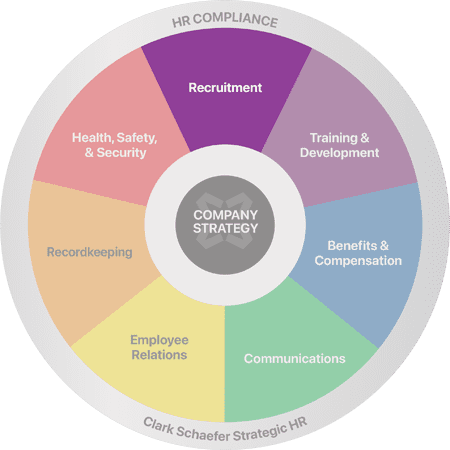How to Develop a Strategic Plan for Your Business
Last Updated on November 2, 2022 / HR Strategy
Creating a strategic plan for your business or new division is like creating a map for an exciting, but unfamiliar, journey. This map will help to keep you on course if you start going in the wrong direction, but it isn’t so stringent that you can’t check out different roads along the way. As a business owner, I use this process each year during my strategic planning sessions: I map out where I am, where I want to go, and how I think I can get there. During the year, my map is both a guide for what I should be focusing on, as well as a resource to help me “check where I am” whenever I am tempted by something new and different. Sometimes, I rewrite my plan based on unforeseen changes (i.e., technology, COVID, economy, emerging trends), but many times it has helped me realize what is most important for the business and make the right decisions with various opportunities and threats to ensure my long-term goals are met.
There are many formulas or formats used for strategic planning, but for the most part, they cover the same points and reach the same goals. Below is an overview of the process that I use personally, as well as what we use with many of our clients.
How to Complete Internal and External Analysis
Part of mapping out your journey requires you to take a strategic look at your business. Your first step will be to determine where you are in the market by doing a “SWOT” analysis — identifying your internal Strengths and Weaknesses as well as external Opportunities and Threats.
Internally, this includes assessing both the strengths and weaknesses of your human, financial and technological resources, as well as the culture and values of the organization. The best way to do this is by brainstorming. Create two columns — one for strengths and one for weaknesses — and begin writing down anything that comes to mind as a strength or weakness to your business. For example, one of Strategic HR’s strengths is the “ability to be a change agent — very flexible and adaptable as needed” while a challenge is “managing our team’s growth.”
An external analysis requires you to evaluate what’s going on “outside” your business and how it may affect you. As discussed in Christine Keen’s book, Effective Strategic Planning: A Handbook for Human Resources Professionals, you should consider issues in the following four categories: economic (i.e., unemployment, interest rates, recession), political (i.e., current or pending legislation or court cases), social (i.e., values, lifestyles, and demographics) and technological. For example, from my external analysis, an opportunity was “Volunteer opportunities with complementary organizations” and a potential threat was “Growth of individuals starting to do human resources consulting.”
Gathering this internal and external information will give you a snapshot of where you are now — the starting point on your journey. However, a starting point, by itself, will not enable you to achieve your goals. Like going on a trip, you need both a starting point and a destination. This reminds me of my favorite quote from Alice’s Adventures in Wonderland:
“I just wanted to ask you which way I ought to go?”
“Well, that depends on where you want to get to,” said the Cat.
“It really doesn’t matter…” said Alice.
“Then it really doesn’t matter which way you go,” said the Cat.
Developing Your Vision and Mission
Next, you’ll need to determine your destination — in other words, your Vision or preferred future. A Vision can be summarized in a short statement that is quickly and easily understood by anyone; it describes something different for the organization. As a sample, below is Teach for America’s Vision statement (at one point in time):
“One day, all children in this nation will have the opportunity to attain an excellent education!”
Next, you need to develop your Mission statement or a statement explaining why you exist. Like the Vision, the Mission is also a short statement. But, a Mission statement describes what the organization does which will help it progress toward its ultimate future, the Vision. For example, Tesla’s Mission statement is
“To accelerate the world’s transition to sustainable energy.”
As you begin to develop your Vision and Mission, you will find it easier if you brainstorm again. This time, think about what’s important to you and to your business — who are your customers, what makes you different, how would your clients describe you, what can you contribute or offer to others, what would you like to do or be tomorrow? Developing the Vision and Mission are the most difficult. Initially, this may take a number of rewrites with input from others. For additional examples, check out HubSpot’s 17 Truly Inspiring Vision and Mission Statement Examples. Once you have both the Vision and Mission clearly defined the rest of your plan will fall right into place.
Create Specific and Measurable Objectives
Now to answer Alice’s question to the Cat… Once you know where you are and where you want to go, you can then map the directions for getting there. In other words, you can identify the key objectives that must be met after this planning period to progress toward your Mission and Vision. Generally, your objectives should be specific and measurable. In addition, they need to be ambitious but realistic, and only focused on what needs to be done rather than how. For example, an objective may be:
“Develop a partner program to help grow business referrals.”
Your list of objectives will quickly grow but you have to narrow down the top four or five that help advance your business toward meeting your Vision and provide you with a competitive advantage. If the list is too long, your plan will quickly become a “dead” document rather than a “living” document that you can use and refer to throughout the year.
Develop an Action Plan for How to Meet Each Objective
For each of your objectives, you will then need to create a detailed action plan identifying “how” you will meet the objective. I’ve had the most success with this by completing the following formula for each objective:
Desired Results
- What are you hoping will happen or your desired result if the objective is met?
- How will you benefit?
Potential Obstacles / Barriers
- What might prevent you from completing this objective?
Supports
- What resources, people, or tools are available to help you with this objective?
Process
- What steps must we take to achieve this objective?
- Be specific on each step indicating who will do what and when.
Evaluation
- How will we know when we’ve successfully met this objective?
This may seem like a lot of work for each objective, but if you map out the answer to all five of these steps, you will have a very clear and unquestioned plan for how your objectives will be met.
Implementation and Evaluation of Your Business Strategic Plan
The hardest step in this process is the next one — implementation! Don’t let yourself do all of this planning and throw the end product on the shelf until next year. If you do, where will you be at the same time the following year? Will you be any closer to your preferred future? (Hint — the answer is no!)
To help ensure that you are proactively working toward these goals, you need to check back on your business plan often — at least quarterly or when anything significant happens to change your plan (i.e., pandemic, economic shift). Has anything changed? Are you on target? Do you need to modify any of the plans? The strategic plan for your business is a living document, so it may change; this is okay as long as you are aware of the changes and make them yourself rather than them being made for you.
Developing a strategic plan for your business isn’t an easy process and can be extremely exhausting. But, if you create an effective and realistic strategic plan for your business, you will begin to focus resources today toward meeting your goals for tomorrow. Plus, you will have a tool to help you minimize the threats and maximize the opportunities. One of the most important benefits of effective strategic planning is that it provides you with a fresh start by clarifying where you are, where you are going, and how you are going to get there. You should re-evaluate your strategic plan on an annual basis using a planning horizon between 2-5 years. Each year, you may find that a great deal changes but your preferred future will stay status-quo until you reach it – and you will!
Thank you to Robin Throckmorton, MA, SPHR, SHRM-SCP, HR Consultant Emeritus, Retired Shareholder in Charge for sharing her expertise on Strategic Planning.
Need help tackling your HR Strategy for the rest of the year? Let our team of HR experts assist in laying out your road map. Please visit our HR Strategy page, or simply contact us – we’d love to hear from you.








